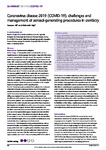Coronavirus disease 2019 (COVID-19): challenges and management of aerosol-generating procedures in dentistry
| dc.contributor.author | Ali, Kamran | |
| dc.contributor.author | Raja, M | |
| dc.date.accessioned | 2020-06-26T13:05:48Z | |
| dc.date.available | 2020-06-26T13:05:48Z | |
| dc.date.issued | 2020-06-26 | |
| dc.identifier.issn | 1462-0049 | |
| dc.identifier.issn | 1476-5446 | |
| dc.identifier.uri | http://hdl.handle.net/10026.1/15817 | |
| dc.description | Embargo removed due to subject matter. | |
| dc.description.abstract |
Data sources Experimental investigation.Study design A retrospective review to evaluate the use of a negative-pressure otolaryngology viral isolation drape (NOVID) system to reduce cross-infection through aerosol. The apparatus consists of a plastic drape suspended over the surgical field in the head and neck region with a smoke evacuator suction placed inside the chamber with an ultra-low penetrating air (ULPA) efficiency rating and a fluid suction high-efficiency particulate air (HEPA) filter compartment. Spread of patient secretions and droplet formation was evaluated using 1% fluorescein dye in 10 ml of normal saline and ultraviolet light. The dye was applied topically in the nasal cavity and nasopharynx preoperatively and intraoperatively prior to the use of instruments such as micro-debrider, electrocautery and high-speed drilling. Following completion of the surgical procedure, an ultraviolet Wood's lamp was used to evaluate the presence of droplets on the surgical drapes and surgical gowns of the operating team.Results The study sample consisted of four patients who underwent endonasal endoscopic surgical procedures; two of these patients required concurrent endoscopic sinus surgery. A micro-debrider was used in three cases; electrocautery in three cases, while a high-speed drilling was employed in two cases. Presence of fluorescein was identified around the patients' nares; on the chest wipe and instrument tray in all four patients. Dye contamination was noted on the gauze placed over the smoke evacuator (two cases of skull base surgery); no fluid droplets were identified beyond the nares or the smoke evacuator (two cases of sinus surgery). However, fluid contamination was identified underneath barrier several centimetres away from the nares (one case of trans-sphenoidal surgery). Droplets were also identified on the surgeon's gown in the abdominal region in all cases and on the arm region in one case. In one case, droplets were also identified on the abdominal region of the nurse, but this was attributed to cross contamination from surgical gauze and instruments. Conclusions This retrospective study provides preliminary data on aerosol and droplet contamination during endonasal and transoral surgery performed under a negative pressure isolation drape system. Although the authors did not screen patients for SARS-CoV-2, they propose smoke evacuator ULPA filter attachment is appropriate to capture particles down to 0.1 microns including SARS-CoV-2 which is 0.125 microns. It would be helpful to see direct evidence to support this claim in future studies. The authors have not provided details regarding set-up time and training requirements for effective application of the isolation drape apparatus or the associated costs etc. It would have also been helpful if the authors could comment on any potential difficulties in undertaking the surgical procedure with the isolation system in place. The sample size is limited to four patients and variations in the magnitude and extent of aerosol contamination needs to be investigated further before drawing any conclusions. Although unlikely, this study design did not capture the presence of aerosol/droplets in the air within the operating room which may follow removal of the isolation drape system or from exposed surgical instruments. Notwithstanding the limitations of the design, negative-pressure aspiration of air under a chamber barrier is likely to minimise the contamination from aerosol and droplet during endonasal and transoral surgery. | |
| dc.format.extent | 44-45 | |
| dc.format.medium | ||
| dc.language | en | |
| dc.language.iso | en | |
| dc.publisher | Springer Science and Business Media LLC | |
| dc.subject | Aerosols | |
| dc.subject | Betacoronavirus | |
| dc.subject | COVID-19 | |
| dc.subject | Coronavirus | |
| dc.subject | Coronavirus Infections | |
| dc.subject | Dentistry | |
| dc.subject | Humans | |
| dc.subject | Infectious Disease Transmission, Patient-to-Professional | |
| dc.subject | Pandemics | |
| dc.subject | Pneumonia, Viral | |
| dc.subject | Retrospective Studies | |
| dc.subject | SARS-CoV-2 | |
| dc.title | Coronavirus disease 2019 (COVID-19): challenges and management of aerosol-generating procedures in dentistry | |
| dc.type | journal-article | |
| dc.type | Journal Article | |
| plymouth.author-url | https://www.ncbi.nlm.nih.gov/pubmed/32591652 | |
| plymouth.issue | 2 | |
| plymouth.volume | 21 | |
| plymouth.publication-status | Published | |
| plymouth.journal | Evidence-Based Dentistry | |
| dc.identifier.doi | 10.1038/s41432-020-0088-4 | |
| plymouth.organisational-group | /Plymouth | |
| plymouth.organisational-group | /Plymouth/Faculty of Health | |
| plymouth.organisational-group | /Plymouth/Users by role | |
| dc.publisher.place | England | |
| dcterms.dateAccepted | 2020-05-30 | |
| dc.rights.embargodate | 2020-6-30 | |
| dc.identifier.eissn | 1476-5446 | |
| dc.rights.embargoperiod | Not known | |
| rioxxterms.versionofrecord | 10.1038/s41432-020-0088-4 | |
| rioxxterms.licenseref.uri | http://www.rioxx.net/licenses/all-rights-reserved | |
| rioxxterms.licenseref.startdate | 2020-06-26 | |
| rioxxterms.type | Journal Article/Review |


